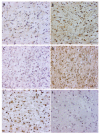Methylation Patterns of DKK1, DKK3 and GSK3β Are Accompanied with Different Expression Levels in Human Astrocytoma
- PMID: 34064046
- PMCID: PMC8196684
- DOI: 10.3390/cancers13112530
Methylation Patterns of DKK1, DKK3 and GSK3β Are Accompanied with Different Expression Levels in Human Astrocytoma
Abstract
In the present study, we investigated genetic and epigenetic changes and protein expression levels of negative regulators of Wnt signaling, DKK1, DKK3, and APC as well as glycogen synthase kinase 3 (GSK3β) and β-catenin in 64 human astrocytomas of grades II-IV. Methylation-specific PCR revealed promoter methylation of DKK1, DKK3, and GSK3β in 38%, 43%, and 18% of samples, respectively. Grade IV comprised the lowest number of methylated GSK3β cases and highest of DKK3. Evaluation of the immunostaining using H-score was performed for β-catenin, both total and unphosphorylated (active) forms. Additionally, active (pY216) and inactive (pS9) forms of GSK3β protein were also analyzed. Spearman's correlation confirmed the prevalence of β-catenin's active form (rs = 0.634, p < 0.001) in astrocytoma tumor cells. The Wilcoxon test revealed that astrocytoma with higher levels of the active pGSK3β-Y216 form had lower expression levels of its inactive form (p < 0.0001, Z = -5.332). Changes in APC's exon 11 were observed in 44.44% of samples by PCR/RFLP. Astrocytomas with changes of APC had higher H-score values of total β-catenin compared to the group without genetic changes (t = -2.264, p = 0.038). Furthermore, a positive correlation between samples with methylated DKK3 promoter and the expression of active pGSK3β-Y216 (rs = 0.356, p = 0.011) was established. Our results emphasize the importance of methylation for the regulation of Wnt signaling. Large deletions of the APC gene associated with increased β-catenin levels, together with oncogenic effects of both β-catenin and GSK3β, are clearly involved in astrocytoma evolution. Our findings contribute to a better understanding of the etiology of gliomas. Further studies should elucidate the clinical and therapeutic relevance of the observed molecular alterations.
Keywords: APC; DKKs; GSK3β; Wnt signaling; astrocytic brain tumors; β-catenin.
Conflict of interest statement
All authors declare that they have no conflict of interest.
Figures






References
-
- Louis D.N., Perry A., Reifenberger G., von Deimling A., Figarella-Branger D., Cavenee W.K., Ohgaki H., Wiestler O.D., Kleihues P., Ellison D.W. The 2016 World Health Organization Classification of Tumors of the Central Nervous System: A Summary. Acta Neuropathol. 2016;131:803–820. doi: 10.1007/s00401-016-1545-1. - DOI - PubMed
-
- Glibo M., Serman A., Karin-Kujundzic V., Bekavac Vlatkovic I., Miskovic B., Vranic S., Serman L. The Role of Glycogen Synthase Kinase 3 (GSK3) in Cancer with Emphasis on Ovarian Cancer Development and Progression: A Comprehensive Review. Bosn. J. Basic Med. Sci. 2021;21:5–18. doi: 10.17305/bjbms.2020.5036. - DOI - PMC - PubMed
Grants and funding
LinkOut - more resources
Full Text Sources
Miscellaneous

